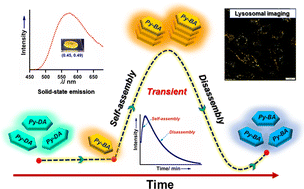Harnessing solution and solid-state emissive materials from aliphatic biogenic amine-induced transient assembly and spontaneous disassembly†
Abstract
Molecular self-assembly can be described as an appealing approach to uncovering numerous exciting and undesired outcomes, worthily useful in a vast realm of real-world applications. Apart from the elegant synthetic design of organic chromophores, creating a pathway to drive the self-assembly in a solution is always desirable. Inspiringly, this study elucidates how the aliphatic biogenic amines (BAs) influence the transient assembly and disassembly of a pyrene dianhydride (Py-DA)-based scaffold via the nucleophilic reaction. The evolution of the transient assembly via ground-state pre-association and disassembly was established from detailed spectroscopic and microscopic investigations. The driving forces for the stabilization of ground-state aggregate were accessed to be strong H-bonding and π–π interactions between polar pyrene-biogenic amine (Py-BA) conjugates, as unraveled by computational study. HRMS and IR measurements validated the existence of Py-BA conjugates in an open conformation, and NMR analysis also manifested the formation of a mixture of two regioisomers (major >85%) in addition to dimer (minor, <15%) in the solution. The rate of both assembly and disassembly in the solution was affected by the alkyl chain length in the BA skeleton. The reaction-based association–dissociation process eventually assisted in a smooth transition of cyan emission (Py-DA) to yellow (Py-BA excimer) to light blue (Py-BA monomer) through an intermediate white light emission in the solution. The light-blue emissive Py-BA conjugates appeared as yellowish-orange solid-state emitters. Finally, selective Py-BA conjugates were found to be of potential biological significance as they were exclusively localized in the lysosomal compartment of the live cells. Moreover, the stimulated lysosomal membrane-degradation could be visualized through confocal microscopy. This work exemplifies the conversion of a non-polar substrate into water-soluble products via transient assembly and disassembly.

- This article is part of the themed collection: FOCUS: Recent progress on bioimaging technologies


 Please wait while we load your content...
Please wait while we load your content...